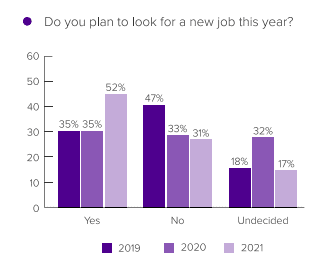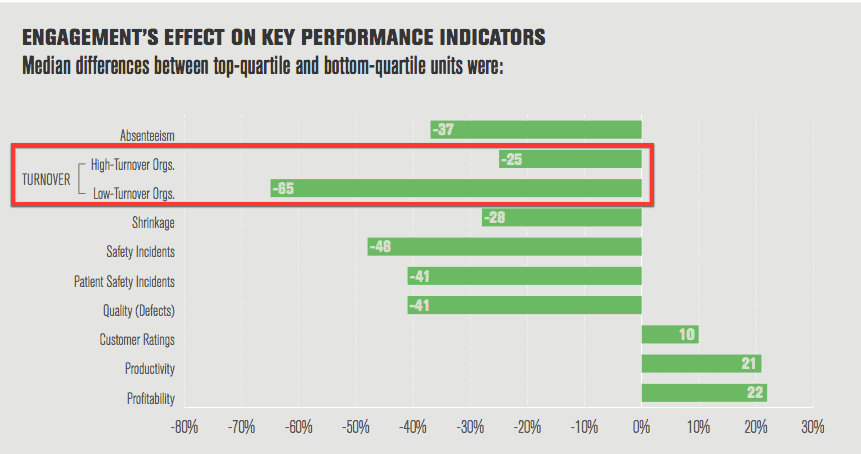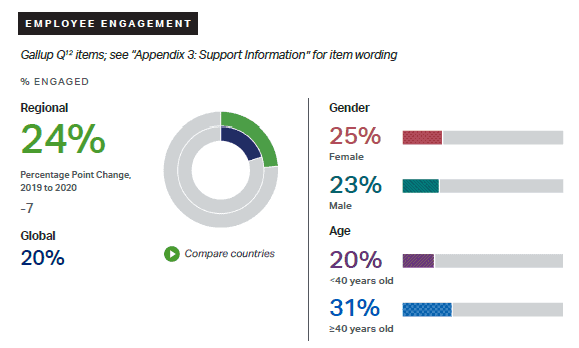How can you tell which of your managers have real leadership potential and which ones are just not cut out for their role? What red flags and signs of bad leadership do you need to be aware of on your team?
Identifying and fixing issues caused by bad management has never been more important. According to a report from the MHA, more than half of employees in the United States wanted a new job in 2021, and that number is expected to go up in 2022.
The main issue? A lack of support from their manager in the face of issues such as burnout, workplace stress, and other problems caused by the COVID-19 crisis. Last year’s data from studies by Gallup proved yet again that people leave managers, not companies.
And unless you want to get caught in the “turnover tsunami”, too, you need to recognize signs of bad leadership among your managers and help them and their teams before it’s too late.
5 Bad Leadership Qualities and How to Deal with Them
In today’s post, we’ll break down 5 things that are a tell-tale sign that your managers need to improve their skills – and what signals to look out for to determine a lack of someone’s long-term leadership potential.
Table of Contents:
- They’re dealing with high turnover
- Their team’s engagement levels are low
- Their teams are not producing new leaders
- You’re getting negative feedback about them from skip level 1 on 1s
- They have bad leadership habits

1. They’re dealing with high turnover
High turnover rates are the biggest indicator of a manager’s bad performance. If many people are quitting a manager, or the manager has fired a lot of people, you need to talk to them ASAP to find out what’s going on.
The more you delay this discussion, the worse the consequences you’ll have to face. In 2015, Gallups study titled "The State of the American Manager" revealed a harsh truth:
50% of US employees have quit to "get away from their manager at some point in their career."
And, of course, with all the instability caused by the ongoing health crisis, the percentage of people who wanted to change jobs shot up by 20% in 2021, as shown in this Achievers report:

Now, when a person on your manager’s team leaves, it costs an average of 6-9 months of their salary to identify and onboard their replacement, according to a study by the Society for Human Resource Management. Now imagine those effects multiplying after several people on a team decide it’s time to find a new job. Can you afford that?
Of course, high turnover rates are particularly bad because by the time so many are quitting, there’s a lot of damage to your company. So, is there a way to catch this issue earlier and prevent these hard-hitting consequences?
Look out for transfer requests to and from different teams
A good way to catch issues before turnover rates snowball is to review transfer requests to and from different teams regularly. If people are regularly asking to leave one particular team, that’s a sign people like your company, but not this manager.
Conversely, if people are regularly asking to join a certain manager’s team, that’s a strong sign they’re a solid manager people like working with.
Use transfer requests as an advance warning that a manager may be struggling in their role. Let them know what they need to correct in their behavior and that you will have to replace them if they fail to do so.
For more ideas on how to help your managers prevent waves of turnover, you can check out these links:
- Why Your Employees Leave In Waves + How To Fix Your Growing Employee Turnover Rate
- 4 Potential Concerns Causing High Employee Turnover In 2021 According To Gallup And Others

2. Their team’s engagement levels are low
Another indicator of bad leadership at your company is tied to low engagement rates among team members.
A recent Gallup study found that "the manager accounts for at least 70% of the variance in employee engagement."
The same study found that low employee engagement negatively impacts turnover rates, as shown by this chart:
It’s as simple as this: if someone likes their job and is engaged, there's a much lower chance of them thinking about interviewing somewhere else or leaving.
Unfortunately, findings from Gallup and the Achievers from 2021 show that engagement is still shockingly low among employees in the United States.

We know low engagement contributes to much higher turnover rates, lower productivity, and worse performances. But what can you do to monitor engagement among your managers’ teams and ensure it’s not dropping dangerously low?
Periodic engagement surveys help you see the bigger picture
Conduct engagement surveys on a regular basis (ideally 1-4 times a year). Doing this will create two big wins for you - not only will you get better insight into how your managers are performing, but you will also show team members you care about their opinion on a consistent basis.
Keep a few things in mind when choosing the timing:
- Avoid peak holiday seasons to ensure everyone participates and isn’t distracted
- Schedule surveys during slow periods so everyone has enough time to think through their answers
- Avoid conducting the survey during cycles that could skew the results positively or negatively (ie- right after a bonus, or pay cuts)
- Be sure to follow up on the results, so people know you were listening, and managers take action to improve on areas of weakness.
With a clearer understanding of engagement rates at your company, you’ll find it easier to spot the bad leaders on your team and act before they cause irreversible consequences like more people leaving.
Here are a couple of other posts about engagement you can read:
- The Two Words Leaders Should Fear Most That Cause Employee Disengagement
- What Managers Must Know From The Gallup Employee Engagement Survey

3. Their teams are not producing new leaders
One of the most important leadership skills for long term success is effectively identifying candidates for future leadership roles and developing them into leaders.
Managers who have that ability are a true asset for your company because they provide value beyond just themselves.
In contrast, managers who can’t recognize and nurture leadership potential often fall into the trap of the Peter Principle, a management concept developed by Laurence J. Peter, who said:
“People in a hierarchy tend to rise to "a level of respective incompetence": employees are promoted based on their success in previous jobs until they reach a level at which they are no longer competent, as skills in one job do not necessarily translate to another.”
In other words, bad managers will just promote people based on success in previous roles (or for political reasons) without really thinking about or recognizing what makes great leaders.
As a result, these people will hit their ceiling and stagnate, as their promotion was not how fit they were to become leaders nor the . Making matters worse, the lack of support from a bad manager can make it difficult for a new leader to grow and succeed, meaning it’s not just individual contributors who may suffer under a bad manager.
Knowing this, what can managers do to bring out leadership potential in their team members?
Learn from the great Bill Walsh
Bill Walsh is known as one of the greatest coaches in NFL history. He took over the San Francisco 49ers, the worst team in the league, and transformed them into a powerhouse that won 4 titles over the next 10 years.
What’s even more impressive about Walsh is the network of head coaches who developed as a result of his methods.
He managed 8 future head coaches, who in turn developed another 35 head coaches in the NFL.

Walsh serves as a reminder that the highest level of leadership is making more leaders.
So, what lessons can Bill Walsh teach your managers about developing future talent?
He discussed this in the book, "The Score Takes Care of Itself" which we previously wrote a post about. These are the principles he mentions as key for getting the most out of potential leaders:
- Praise is one of the best tools at a leader's disposal, as it gives you an opportunity to show everyone an example of what they need to strive for.
- Preparation and planning for all possible outcomes is critical. Walsh taught his coaches and players that "the more thorough, the more extensive, the more rehearsed, the better you perform under the pressure of any situation that calls for an immediate decision."
- Leadership is about the example you set and the culture you create. The way you get others to follow you is demonstrating you deserve to be followed.
- Your enthusiasm is contagious and essential to teaching. Imagine someone presenting a boring PowerPoint deck in a monotone voice. Now imagine someone who is really passionate about what they do. Who would you rather follow?
- Use the four most powerful words in a manager's arsenal: “I believe in you.” Walsh considered pushing people to do great things the best part about management. A big part of that was letting them know just how much he believed in their abilities and potential.
If one of your managers is struggling with developing talent, check for these signs (or a lack of them) and coach them on implementing Bill Walsh’s ideas to start building future leaders.
Here’s the link to our post on Walsh and some other ways to help your managers see who on their team has leadership potential and how to develop it:
- 5 Key Bill Walsh Quotes On Leadership From The Score Takes Care Of Itself
- Recognizing A Great Future Leader: 4 Senior Manager Traits To Look Out For
- 15 Skills Senior Leaders Must Master To Be Great Managers Of Managers
4. You’re getting negative feedback about them from skip level 1 on 1s
As a senior leader, you may feel like you have a pretty good understanding of what’s going on at your company. But even engagement surveys or asking your managers how their teams are doing directly may not be enough.
If you suspect things aren’t going as planned for one of your managers, you should ask their team members about it. The best way to do that is through skip level meetings.
Skip level meetings (or Skip Level 1:1s) are one of the most powerful tools for understanding how people deeper in your organization truly feel.

They are check ins between you and the direct reports of the managers under you. They allow you to gather valuable micro- and macro-level feedback you wouldn’t have been able to get otherwise.
Whether you get the sense that something is off with one of your teams, or you just feel out of touch and you want to get a pulse on how things are going, skip level 1 on 1s give you a great way to find out.
Try this to get the most out of skip level 1:1s
There is one simple question that can help unlock a sea of insights in your skip level meetings:
"Have you talked to your manager about this?"
How a team member responds can reveal the root cause of an issue on your team. If they hadn’t thought to or were too afraid, this will encourage them to fix that.
If, however, they tried talking to their manager to no avail, it’s a likely sign of bad leadership.
If that’s the case, you can coach the manager on building more trust, or help them behind the scenes and guide them until they improve in the problematic area you learn about from their team members.
We usually recommend having ski level 1 on 1s every 3-6 months (less frequent the bigger your teams), but if you’re sensing one of your managers is struggling, and you aren’t sure why, it’s okay to have them as often as once a month until you resolve the issue.
With skip level 1 on 1s, not only can you find out if and why your manager is struggling, but engage both them and their team to try to find a solution.
For more information and tips on skip level 1 on 1s, check out the following links:
- Tips for Skip Level Meetings;
- Questions for Skip Level Meetings;
- How To Use Skip Level 1 On 1s To Majorly Improve Your Managers As A Senior Leader.
5. They have bad leadership habits
Most of the things we’ve talked about so far are lagging indicators; there has to already be significant problems before they’ll indicate to you there are issues with a manager.
For the advanced leaders reading this, you of course want to get well ahead of these issues, or even outright prevent them.
But how do you do that?
The key is to understand the habits that good leaders have and that are either broken, or done poorly when a manager is practicing bad leadership.
Here’s a few of those habits to take a look at for the earliest warning signs:

Are they having 1:1s? How often? Are they making the most of them?
The power of 1:1s is something we’ve written about on numerous occasions and has been proven to solve issues such as:
- A lack of communication
- Brewing frustrations and issues at work
- Team and interpersonal conflicts
- Unclear purpose of work
- A lack of career growth
According to Gallup, employees who do have regular 1:1s with their managers are 3 times more likely to be engaged than those who don’t. Adobe and GE saw huge spikes in productivity after implementing them, too.
If one of your managers keeps rescheduling or canceling their 1:1s, they’re missing out on these benefits. They’ll also have a much more difficult time detecting issues before they start causing irreversible damage.
Check their calendar or ask them how often they’re meeting with team members for their 1:1s (ideally weekly or bi-weekly). Ask them how they usually prepare for meetings - do they have a 1:1 meeting agenda? Do they know what good questions to ask a manager in different situations to make the most of them?
If they’re not consistent about having these check-ins and do a poor job preparing for them, there’s a lot of room for improvement. To avoid the problems we’ve shared in previous sections, you should address these issues with their 1 on 1s as soon as possible.

Are they taking credit for their team's work or praising them? When there’s an issue, do they throw people under the bus or share the responsibility?
You’ve probably heard the saying, “Leaders eat last.” It speaks to the idea that great leaders embody the values they want to see in their team and lead by example.
We’ve mentioned Bill Walsh believed in this, and the quote from Nelson Mandela above shows he’s not the only one. How a manager treats their team is key to being able to motivate them.
Unless a manager is willing to roll up their sleeves and set a good example, they’re unlikely to be respected as a leader. That is especially the case if they’re taking credit for their team’s success, or blaming them when things go wrong.
You’ll discover this sort of issue by observing your managers in action day to day. How do they handle meetings in large groups? Are they supporting their team and advocating for them, or focusing on themselves? You can also see how they speak to you when you talk to them 1 on 1. In this case their words will speak loudly and hint at possible problematic actions.
Conclusion
The consequences of bad leadership at your company can be very costly. It can damage morale, cause turnover that leads to high costs for replacing them, and demotivates even team members who stay.
The bottom line is you cannot afford bad managers. And you can especially not afford to wait to find out if you have them.
To get out in front of these potential issues, review your managers’ work regularly and look out for the 5 signs of bad leadership we discussed today. Once again, they are:
- High turnover rates or transfer requests
- Low engagement scores
- Their inability to effectively select or develop leaders on their team
- Bad feedback about them from skip level 1:1s
- Inconsistent and poor management habits
These warning signs can help you triage a growing problem or catch it before it becomes too costly.
The main takeaway here is to be proactive and not wait for turnover or poor annual reviews to find out how your managers are really doing. This could mean the difference between causing waves of turnover and creating a culture of great leaders with engaged, motivated team members.





